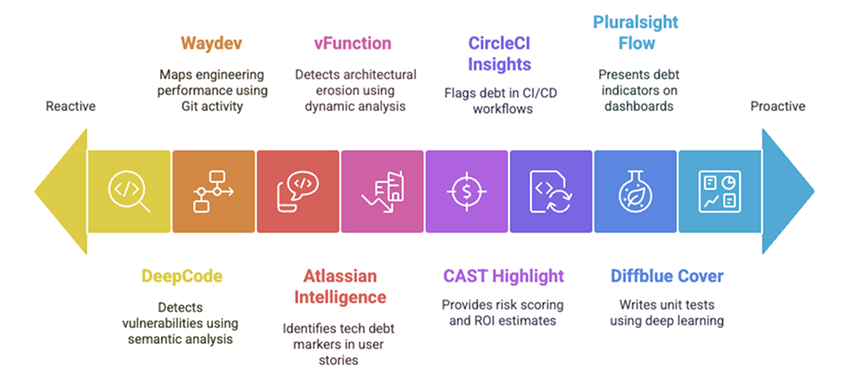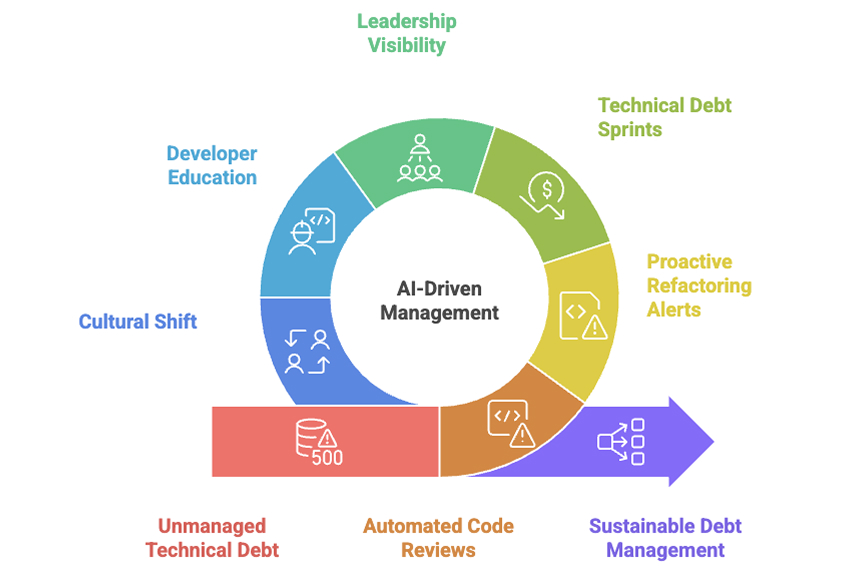Software teams move fast-and sometimes too fast. New features get released quickly, shortcuts are taken, and small issues start to build up. This buildup is called technical debt. If it’s not managed, it can slow down progress and cause more problems later.
That’s where AI can help. It doesn’t just spot bad code or missing tests; it helps teams see the full picture. AI can track, measure, and even predict technical debt. Instead of guessing, teams get clear data to make better decisions. In short, AI helps teams move quickly without causing long-term damage.
What is Technical Debt?
Technical debt refers to the cost of rework incurred by taking shortcuts in software development. Like financial debt, it builds up “interest” over time, making future updates slower and more expensive. It quietly accumulates in the background, often unnoticed, until systems become harder to maintain or change.
Common causes of technical debt include:
- Rushed delivery timelines
- Lack of documentation or testing
- Poor architectural decisions
- Legacy code and outdated libraries
- Frequent pivots without proper refactoring
But not all technical debt is bad. Just like taking a loan can help a business grow, some technical debt is taken on purpose-to launch faster or test an idea quickly. The real issue starts when this debt isn’t tracked, measured, or managed. Over time, this can compromise software quality, making it more challenging for the business to scale.
If left unchecked, technical debt can lead to more bugs, slower release cycles, low developer morale, and unstable systems. These problems can turn into real costs and missed opportunities for a business.
How to Measure Technical Debt with AI
Traditional methods of measuring technical debt often rely on static code analysis tools or subjective engineering evaluations. While useful, these approaches fall short when teams need granular, scalable, and context-aware insights.
AI-driven technical debt analysis introduces a shift from reactive guesswork to predictive clarity.
Here’s how.
1. AI-powered Code Intelligence
Machine learning algorithms can scan repositories, evaluate code patterns, and flag areas that deviate from best practices. Unlike rule-based linters, these systems evolve with the codebase, learning from past incidents and ongoing development trends.
Examples:
- DeepCode (now part of Snyk): Uses semantic analysis and machine learning to detect vulnerabilities and code quality issues.
- CodeScene: Provides predictive analysis and visualizes hotspots, code health, and developer experience.
Some platforms also apply unsupervised learning to identify code anomalies that don’t match the rest of the codebase-an early warning for hidden debt.
2. Historical Velocity and Churn Analysis
AI models can analyze version control history-tracking how long features take to ship, how frequently files are changed, and which modules attract the most bug fixes. These patterns reveal latent hotspots of instability.
Examples:
- Waydev: Uses Git activity to map engineering performance and velocity changes.
- LinearB: Correlates pull requests and commit patterns with business metrics to surface inefficiencies.
By comparing past performance with organizational benchmarks, teams can spot slowdown zones even before developers raise concerns.
3. Natural Language Processing on Documentation and Tickets
Using NLP, AI can scan commit messages, pull request comments, and issue trackers to identify recurring themes such as “temporary fix,” “hack,” “urgent patch,” or “legacy workaround.” This unstructured data adds a behavioral layer to technical analysis.
AI tools can also highlight gaps in documentation-a subtle but impactful form of debt that affects team onboarding and maintainability.
Example:
- Atlassian Intelligence (in Jira): Surfaces weak or incomplete user stories and tags potential tech debt markers.
4. Automated Architectural Drift Detection
Over time, the intended software architecture may diverge from its implementation. AI tools trained to understand the original design can detect these mismatches. For instance, a microservice architecture that exhibits increasing interdependence or data coupling is a warning sign.
Example:
- vFunction: Uses dynamic analysis to detect architectural erosion and modularity breakdown.
This helps teams spot structural degradation before it becomes systemic.
5. Cost Estimation and Prioritization
Beyond detection, AI can help estimate the cost of fixing specific areas of debt. Correlating code complexity, test coverage, recent defect density, and team velocity assigns a “remediation score” to different modules. This allows tech leads and product managers to make informed trade-offs between technical investment and business value.
Examples:
- CAST Highlight: Provides portfolio-level risk scoring and ROI estimates for remediation.
- Stepsize: Tracks debt directly in your IDE and creates prioritized tasks for fixes.
This kind of measurement goes beyond identifying flaws-it enables effective planning: What should we fix now? What can wait? What’s the cost of doing nothing?
6. Integration with CI/CD Pipelines
AI-enhanced tools can integrate into continuous integration workflows, flagging potential debt as part of code reviews or before deployment. This shifts the culture from periodic cleanup to continuous improvement.
Example:
- CircleCI Insights: Offers AI-enhanced data on build bottlenecks and unstable tests.
By catching potential issues before they reach production, organizations prevent compounding debt over time.
7. AI-based Test Coverage Analysis
Another emerging capability is AI-powered test coverage analysis. Tools evaluate which parts of the codebase are consistently tested, which are vulnerable, and how testing coverage aligns with critical functionality.
Examples:
- Testim.io (by Tricentis): Uses AI to generate, maintain, and optimize tests that evolve with code.
- Diffblue Cover: Automatically writes Java unit tests using deep learning.
By highlighting high-debt, low-coverage zones, teams are empowered to prioritize meaningful test expansions.
8. Visual Dashboards for Leadership
Executives and engineering leaders don’t need to read every line of code—they need high-level indicators. AI tools transform raw data into visual dashboards, offering metrics like:
- Debt-to-code ratio
- Module instability index
- Mean time to resolve debt
- Code churn heatmaps
- Quality trendlines over time
- Team-specific debt ownership
Examples:
- Pluralsight Flow: Presents engineering intelligence dashboards with debt indicators.
- Code Climate Velocity: Visualizes quality trends and decision bottlenecks at team and repo levels.
These dashboards provide an at-a-glance understanding of the impact of technical debt and allow for proactive governance.
Technical Debt vs. Business Alignment
One of the most persistent challenges in software development is the direct conflict between long-term code quality and immediate delivery pressures. Developers want clean, scalable architecture. Business teams want fast releases to stay competitive. The result? Shortcuts, delayed refactoring, and growing technical debt.
But this isn’t just a workflow problem. It’s a deeper disconnect between engineering and business goals.
AI helps bridge this gap by bringing objectivity to conversations that are often based on opinions or politics. Instead of debating priorities without clear data, AI enables alignment through:
- Quantified impact: AI reveals how technical debt slows delivery, increases bugs, and affects customer satisfaction.
- Scenario modeling: Teams can simulate future performance based on different debt remediation strategies.
- Cross-functional visibility: Dashboards and KPIs help both technical and non-technical stakeholders understand the trade-offs.
These insights come from the same tools already used for technical debt analysis. Platforms like Code Climate Velocity, Pluralsight Flow, and Waydev help show how unresolved debt affects delivery speed and system stability. Instead of debating based on assumptions, teams can use this data to prioritize what truly matters for the business.
Best Practices for Managing Technical Debt
Measuring technical debt is just the first step. The real value comes from managing it effectively, and that’s where AI plays a powerful role. It doesn’t just highlight problems; it helps teams take action.
Here are some best practices for managing technical debt with AI:
- Automated code reviews: Integrate AI tools that continuously monitor pull requests and flag technical debt in real-time.
- Proactive refactoring alerts: Use AI to identify refactoring opportunities early when changes are cheaper and less disruptive.
- Technical debt sprints: Dedicate recurring sprint cycles to address high-priority debt, guided by AI prioritization scores.
- Leadership visibility: Ensure CTOs and product leads have access to AI-generated dashboards that track the impact of debt on business KPIs.
- Developer education: Provide AI-generated feedback loops that help developers learn from past mistakes, improving code quality over time.
- Cultural shift: Use AI to normalize conversations about debt, not as blame, but as part of the development lifecycle.
Technical debt will never fully disappear, and that’s okay. The goal isn’t perfection but sustainability. With AI, teams can embrace a future where debt is visible, measurable, and manageable.
Final Thoughts
AI-driven technical debt analysis is no longer an emerging trend; it has become an operational necessity. It enables engineering teams to shift from reactive maintenance to proactive, strategic improvement. By combining code intelligence, historical behavior, and real-time analytics, AI helps bridge the gap between engineering quality and business goals.
The key advantage of AI is its ability to continuously monitor. As code changes, debt grows. Regular analysis enables teams to catch issues early, remain agile, and prevent major problems. This steady visibility helps keep technical debt under control, fostering long-term success.



